A challenging day hike or backpacking trip promises excitement and the opportunity to smash your daily step goal. Depending on factors like weight, individual fitness level, metabolism, pack load, hiking speed, elevation, and terrain, the average person can burn anywhere from 300 to 600 calories per hour. You can also find out how many calories you’ll need to consume for your next hiking trip with our simple calories burned calculator.
Many hikers and backpackers opt for lightweight, compact gear, and this philosophy extends to their diet on the trail, too. Protein and nutrition bars have earned their reputation as the go-to trail snack for those in need of a quick and reliable boost of energy. But step into your local grocery or health food store, and you’ll be greeted with a dizzying assortment of protein, energy, and recovery bars.
Today, we’re sharing our expert tips for choosing the perfect energy bar to match your activity level and dietary preferences, along with our top hiking bar picks that’ll have you snacking away well before you reach the summit.
How To Choose The Best Energy Bar
Let’s explore the factors to consider when choosing the perfect energy bar to fuel your outdoor activities. Spoiler alert: There’s more to it than taste; it’s about giving your body the essential nutrients it craves during an adventure.
Taste and Palatability
When it comes to hiking energy bars, taste is pretty important! There’s no fun in snacking on something that tastes like sawdust while you’re sweating buckets in the middle of the woods. The good news is, you’ve got a world of flavors to explore. Many energy bar brands offer a wide range of options, from classic chocolate to more novel flavors like coconut almond or white chocolate macadamia nut. The best way to pinpoint which energy bars tickle your taste buds is through trial and error. Don’t hesitate to sample different flavors to discover your favorites.
Calorie Count
Hiking and backpacking are calorie-intensive activities, especially when tackling longer or more challenging trails. Energy bars deliver a concentrated burst of fuel to keep your momentum going and banish nagging fatigue. If you’re a weekend warrior or fancy a day hike on your local trails, bringing a meal replacement bar might be overkill. But if you’re prepping for an ultramarathon or long-distance backpacking trip, you’ll need a bar that offers enough calories to offset the massive amounts of energy you’ll expend throughout the day.
Nutrition Considerations
When it comes to hiking nutrition, there are only a few rules of thumb you need to follow. First, calories are your friend. Hiking is a full-body workout that guzzles energy. Fail to meet your caloric requirements during a hike or backpacking trip, and you force your body to run on fumes. Long-term, this could cause more unpleasant consequences like the dreaded “bonk.”
Prioritize energy bars that boast a higher carbohydrate content and protein for muscle recovery. While long-distance hikers prefer candy bars for their abundance of sugar, their nutritional deficiencies leave much to be desired for the health conscious. For the broader outdoor community, the primary objective is to seek high-calorie energy bars containing a balanced macronutrient profile, promising sustained energy and satiety.
Finally, hiking depletes electrolytes via perspiration. One energy bar alone can’t replace all the electrolytes you lose during a long hike. Instead, bring a drink mix/electrolyte tablet (e.g., Nuun, Tailwind, Gnarly Nutrition, Gatorade, LiquidIV, etc.) or energy gel (e.g., Gu, Honey Stinger, etc.) to keep your sodium and potassium levels topped off.
Portability and Packaging
The last thing you want when hiking is to pull out a bar from your pack that’s crumbled or squished beyond recognition. Think about the energy bars you pick in terms of their adventure-readiness. Go for bars that are tougher, chewy in consistency, and efficiently packaged, ready to tackle the rugged challenges of the trail right alongside you.
Price Point
Energy bars come in a wide range of prices, and quality does not always correlate with price. It’s more than possible to find great-tasting and nutritious options at a reasonable cost. The best way to save money on bars is by buying in bulk to cut down your overall expenses. You may also qualify for a pro deal if you work in outdoor recreation, are an emergency responder, law enforcement officer, or are a member of one of the military or government agencies involved with outdoor recreation or the media.
Ingredient Quality
Not all energy bars are created equal when it comes to quality. Seek out bars that contain simple, easy-to-recognize ingredients like nuts, seeds, whole grains, and dried fruits. These ingredients will provide your body with essential nutrients like protein, carbohydrates, and fiber to help keep you feeling more full. The best energy bar ingredients not only make your taste buds sing but fuel your body with the calories and macronutrients it craves for peak performance and rapid recovery.
Often times, bars with all natural ingredients cost more. We understand those struggles! If keeping your bars at a lower budget is essential, going for a lower cost bar is completely okay. While it may not have the healthiest ingredients, they will do the trick! If you are going to consume products with less natural ingredients, we’d argue that the best time to do so is while be active, like hiking or running.
7 Best Energy Bars For Hiking And Backpacking
Note: Although we made every effort to accommodate hikers with special dietary needs, this list is not exhaustive or all-inclusive. If you have specific dietary needs or health concerns, it’s advisable to consult with a healthcare professional for personalized guidance.
CLIF Builders Protein Bar
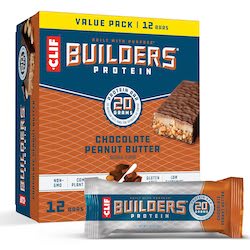 Macros: 280 calories, 20g protein, 9g fat, 31g carbohydrates, 17g sugar, 3g dietary fiber
Macros: 280 calories, 20g protein, 9g fat, 31g carbohydrates, 17g sugar, 3g dietary fiber
Pros: Comes in a variety of flavors, high protein content, gluten-free, vegetarian and vegan-friendly
Cons: May contain peanuts, tree nuts, and soy, some have complained about a chalky aftertaste
Kicking off with a hiker fan favorite, CLIF Builders Protein Bars are gluten-free and vegan-friendly, making them an excellent option for those with dietary restrictions. Each Builders Bar contains 20 grams of protein, promoting muscle recovery and long-lasting energy on the trail. Their commitment to non-GMO ingredients ensures a quality product, but keep in mind their bars are high in sugar and may contain peanut, tree nut, and soy allergens. Detractors have also complained about a hint of chalkiness in the taste department, however, I haven’t found it to be an issue for me.
PROBAR
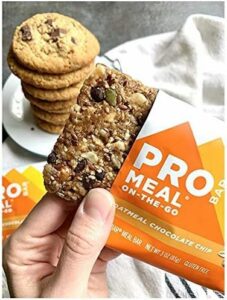 Macros: 400 calories, 11g protein, 22g fat, 43g carbohydrates, 19g sugar, 6g dietary fiber
Macros: 400 calories, 11g protein, 22g fat, 43g carbohydrates, 19g sugar, 6g dietary fiber
Pros: Very nutrient-dense, satisfying and filling, easy to chew, great addition to any emergency kit
Cons: Very sweet, may be too dense for some, low calorie-to-protein ratio
When you’re out on the trails, you want a snack that keeps you fueled, focused and your hunger at bay. Packing over 350 calories per bar, PROBARs are designed to curb your appetite and help you stay energized during all of your outdoor escapades without running out of steam. High in calories, PROBARs are a popular choice among thru-hikers and endurance athletes. Health concerned individuals are quick to point out that PROBARs are made with brown rice syrup, a high-glycemic sweetener. Brown rice syrup can cause rapid spikes in blood sugar levels when consumed. When you’re staring down the barrel of those final set of switchbacks and need a pick-me-up, a quick sugar rush might be just what you need.
Bobo’s Oat Bars
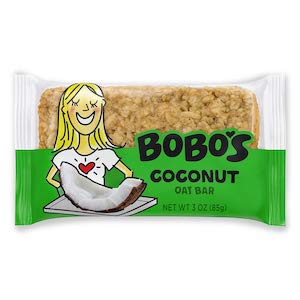 Macros: 340 calories, 6g protein, 12g fat, 62g carbohydrates, 18g sugar, 4g dietary fiber
Macros: 340 calories, 6g protein, 12g fat, 62g carbohydrates, 18g sugar, 4g dietary fiber
Pros: Chewy, compact, great for carb loading before a hike
Cons: Expensive, some complain about the lack of flavor, low protein content
Bobo’s Oat Bars offer an enticing fusion of all-natural ingredients, meticulously crafted to cater to a wide range of dietary preferences, including hikers who favor gluten-free and vegan options. What sets these bars apart is their delightful texture, reminiscent of a densely packed muffin. It’s a unique characteristic that sets them apart from other energy bars on this list. These bars may be compact, but they feel surprisingly substantial with every bite. For hikers like myself who prefer a quick and easy morning meal on the trail, Bobo’s were a constant companion during my Pacific Crest Trail thru-hike when I needed to replenish over 1,000 calories before noon.
GreenBelly Bar
 Macros: 650 calories, 17g protein, 24g fat, 95g carbohydrates, 43g sugar, 9g dietary fiber
Macros: 650 calories, 17g protein, 24g fat, 95g carbohydrates, 43g sugar, 9g dietary fiber
Pros: Extended shelf life, features resealable packaging for lasting freshness, ideal as a meal replacement or calorie-sustaining snack during long-distance hikes or endurance events. These have a high sodium count which can be great for those needing extra sodium.
Cons: Not suitable for people with nut allergies, portion sizes are relatively large, some people complain it tastes too salty
Say goodbye to time-consuming meal prep or boring freeze-dried meals on trail. GreenBelly Meals are made from scratch, with most batches prepared just a week before they ship, delivering a robust, wholesome flavor profile sure to satisfy your taste buds. GreenBelly Meals are not your typical “meals-ready-to-eat” bars, nor are they dense protein bars that feel like you’re biting into steel. Instead, they offer both great taste and nutritional value in a convenient, ultralight package. The zip-seal enclosure keeps your bar crispy and fresh, no matter where your adventure takes you. Whether you’re a stoveless backpacker or simply seeking a delicious meal replacement bar for your upcoming ultramarathon, GreenBelly Bars are your ticket to a satisfying and hassle-free outdoor mealtime.
See On Amazon | See On GreenBelly
Power Crunch Protein Bar
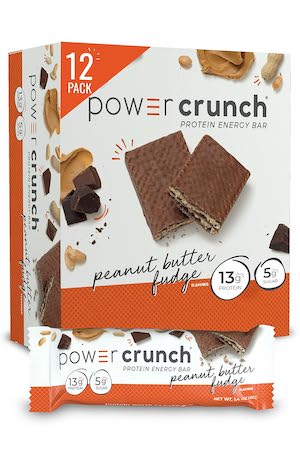 Macros: 220 calories, 13g protein, 13g fat, 11g carbohydrates, 5g sugar, 1g dietary fiber
Macros: 220 calories, 13g protein, 13g fat, 11g carbohydrates, 5g sugar, 1g dietary fiber
Pros: Lightweight, high protein content, wafer-life texture is a delight for many
Cons: Flaky, gets too melty on warm days, not ideal for long-distance backpacking trips
Power Crunch Protein Bars make the perfect carry-on companion for hikers looking for a protein bar that doesn’t skimp on the good stuff. Make a day out on the trails just a bit sweeter by indulging in a protein bar that mimics your favorite desserts. What sets Power Crunch Bars apart is their smart balance of nutrition. While they may be lower in calories and fiber, their simple ingredient list and low sugar content make them a smart choice for folks looking for a healthy source of protein and fat while being mindful of their sugar consumption.
See On Amazon | See On Power Crunch | See On Walmart
Munk Pack Bars
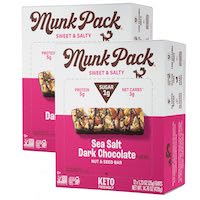 Macros: 150 calories, 5g protein, 12g fat, 13g carbohydrates, 1g sugar, 5g dietary fiber
Macros: 150 calories, 5g protein, 12g fat, 13g carbohydrates, 1g sugar, 5g dietary fiber
Pros: Great for day hikes, the first ingredient is almonds, gluten-free or vegetarian friendly
Cons: Lack in calories and sugar count which may be needed depending upon your activity. Not recommended for people with nut allergies, high calorie-to-cost ratio
Munk Pack bars are an exciting and nutritious twist on the conventional energy bar. Crafted from a blend of fibrous and protein-rich pumpkin and sunflower seeds along with almonds and peanuts, these bars provide a tasty way to meet your daily nutritional needs. Unlike other bars that use sugar alcohols, Munk Pack bars are sweetened with allulose, an easier-to-digest sugar alternative. Munk Pack bars are keto-certified, gluten-free, and plant-based. Now, let’s talk turkey (or rather, the price tag). Each bar clocks in at over $2. That’s not pocket change, especially when you consider that each bar delivers a modest 150 calories. But if you don’t mind investing in a top-tier, lip-smacking, and keto-friendly energy jolt, Munk Pack bars could very well become your favorite hiking snack.
See On Amazon | See on Munk Pack
Gatorade Whey Protein Bar
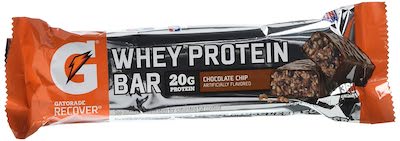
Macros: 350 calories, 20g protein, 13g fat, 41g carbohydrates, 30g sugar, 0g dietary fiber
Pros: Comes in a variety of flavors, if you don’t like the taste of protein bars, this is a good alternative, high protein content. This is a great recovery bar for at camp, or after a long hike!
Cons: Highest sugar content of any bar on this list, most bars are covered in chocolate, which can easily melt in the sun
Gatorade’s expertise in crafting iconic sports drinks extends to their range of Gatorade Whey Protein Bars, each loaded with a whopping 20 grams of protein. These protein-packed energy bars deliver a satisfying blend of nutrition and flavor. For everyday snacking or shorter day hikes, you may want to consider a less sugary alternative. But for ultramarathon beasts and thru-hikers in need of a high-energy protein boost, this ooey, gooey chocolatey delight fits the bill.
See On Amazon | See On Walmart

Ash Czarnota is a freelance writer based in Southern California with over 3,000 trail miles under her feet. She is the founder of Go Galavanting, an online community to celebrate adventurous women and highlight emerging thought leaders in the outdoor industry. A PCT alumni, Joshua Tree enthusiast and burgeoning climber, Ash uses her outdoor experiences to craft content that educates and inspires a rising generation of adventurers to embrace their inner wild. Connect with her on Instagram (@salty_millennial).
